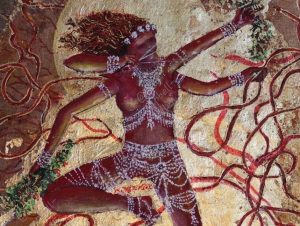
Buddhist meditation is not confined only to calming the mind, and concentrating the mind on an object of meditation. They are only the means to an end. The end is intuitive penetration into the ultimate Truth of a human personality – self-knowledge of one’s True Self. Meditation is certainly not a receipt of a divine message from the Buddha externally. It is a process of Gnosis or Self-awakening of knowing one’s True Self (knowledge of microcosm). True Self is Selflessness or Egolessness (Anatt?). Whoever knows one’s True Self knows the true nature of the cosmos (macrocosm). Man is the image of the cosmos. It is the human mind that creates the cosmos. Therefore, knowing the human mind, one knows the cosmos. Buddhist meditation is the means to know the true nature of the mind and body – their Anatt? (No self-identity and only process becoming).
Buddhist meditation is a process of mental development and self-cultivation of morality (s?la), concentration (sam?dhi) and wisdom (paññ?). More specifically, Buddhist meditation is the mental development and self-cultivation of concentration and wisdom. Concentration is also the means but not the end. It is the means to development of wisdom of insight of knowing one’s True Self. The True Self is that there is no permanent and independent agent that regulates the human six sense activities. The human six sense activities are dependently co-arisen from the unity of existence of the five aggregates of form, feelings, perceptions, volitions and consciousness. The unity of existence of five aggregates is the Absolute Reality of Anatt?. Anatt? means that individual soul does not exist but only the unity of existence of the physical (r?pa) and mental (n?ma) phenomena exist. In other words, the “I’ concept is unreal and illusory. Only the unity of physical and mental elements exist.
Therefore, the primary objective of Buddhist mental development is the development of mental concentration with the ultimate aim of purifying the mind through the knowledge of Anatt?. The mental purification is the complete annihilation of the self-centric ego or the elimination of ‘I’ concept. Thus, the habitual propensity of ‘I’ attachment to likes and ‘I’ aversion towards dislikes is eliminated. The annihilation of self-centric ego or ‘I’ concept requires the development of wisdom of insight. The development of insight necessitates the prior development of concentration. The development of concentration necessitates the prior development of morality. Morality is keeping the Five Precepts (Pañcas?la-s) and the Ten Wholesome Course of Actions (Dasas?la-) so that they are not transgressed.
Broadly categorized, there are only there categories of Buddhist meditation. They comprise tranquility meditation (samatha bh?van?), concentration meditation (sam?dhi bh?van?) and insight meditation (vipassan? bh?van?). All apparently dissimilar meditation methods innovated and expounded by many various Buddhist sects or Buddhist schools of Buddhist thought of either Therav?da tradition or Mah?y?na tradition encompass these three aspects of Buddhist meditation.
Many and various meditation methods are innovations by different Buddhist meditation Patriarchs and Masters to calm and still the unceasingly disturbed human mind. The untrained or unmeditated mind is like a monkey mind that is easily perturbed, dispersed, scattered and obsessed with the internal and external environmental stimuli. The environmental stimuli of sight, sound, smell, taste, touch and thought enter through the gates of six sense faculties of eyes, ears, nose, tongue, body and mind to assail the mind. Therefore, an object of meditation is used to tame the diffusing or dispersing mind so that the scattered mind is focused only upon one primary object of meditation. The object of meditation is recommended by a meditation Patriarch or Master guided by the central teachings of Gotama Buddha. All apparently diverse meditation methods must eventually lead to the Four Establishments of Mindfulness (Catt?ro Satipa??h?na) to purify the mind from moment to moment.
The object of meditation may be either mindfulness of breathing, mindfulness of the movement of abdomen, recitation of the name of Buddha, listening to the external sound, recitation of a mantra, visualization of a Buddha image or any other appropriate object and so forth.
The main task of tranquility meditation is development of mental serenity so that mental concentration is developed to appease the chatter of the human mind. During the state of tranquility meditation, the grasping upon the human body and mind including the method still exists. Succinctly put, the notion of self-centric ego or ‘I’ concept of this is I, this is mine and this belongs to me still exists in the early process of meditation.
When the mind is calmed or tamed by tranquility meditation, the yogi or meditator naturally and effortly proceeds to the second station of Buddhist meditation called the concentration meditation. During the station of concentration meditation, the yogi or meditator is absorbed in mental concentration (jh?na). However, a subtle ‘I’ concept still exists even in the thought of the thought process of mindfulness and clear awareness of the yogi. The notion of ‘my consciousness’ still exists subtlely even the yogi is meditating very well. ‘My-ness’ is ‘I’ concept of self-centric ego. Self-centric ego is grasping or clinging.
The form of phenomenon still exists in the mind of ‘I’ concept. ‘I’ concept is manifest of self (att?). The illusory ‘self’ never exists in the first place. It has been fabricated by a sentient being who has not insightfully discerned the Absolute Reality of Anatt? – the Unity of Existence created by the Law of Dependent Co-arising (Pa?iccasamupp?da).
To be continued in p.2/2 in the March edition, 2010











